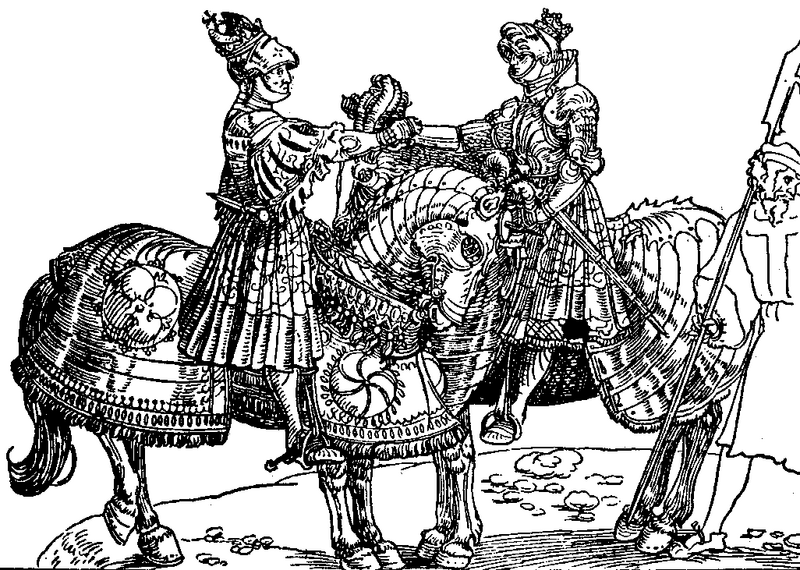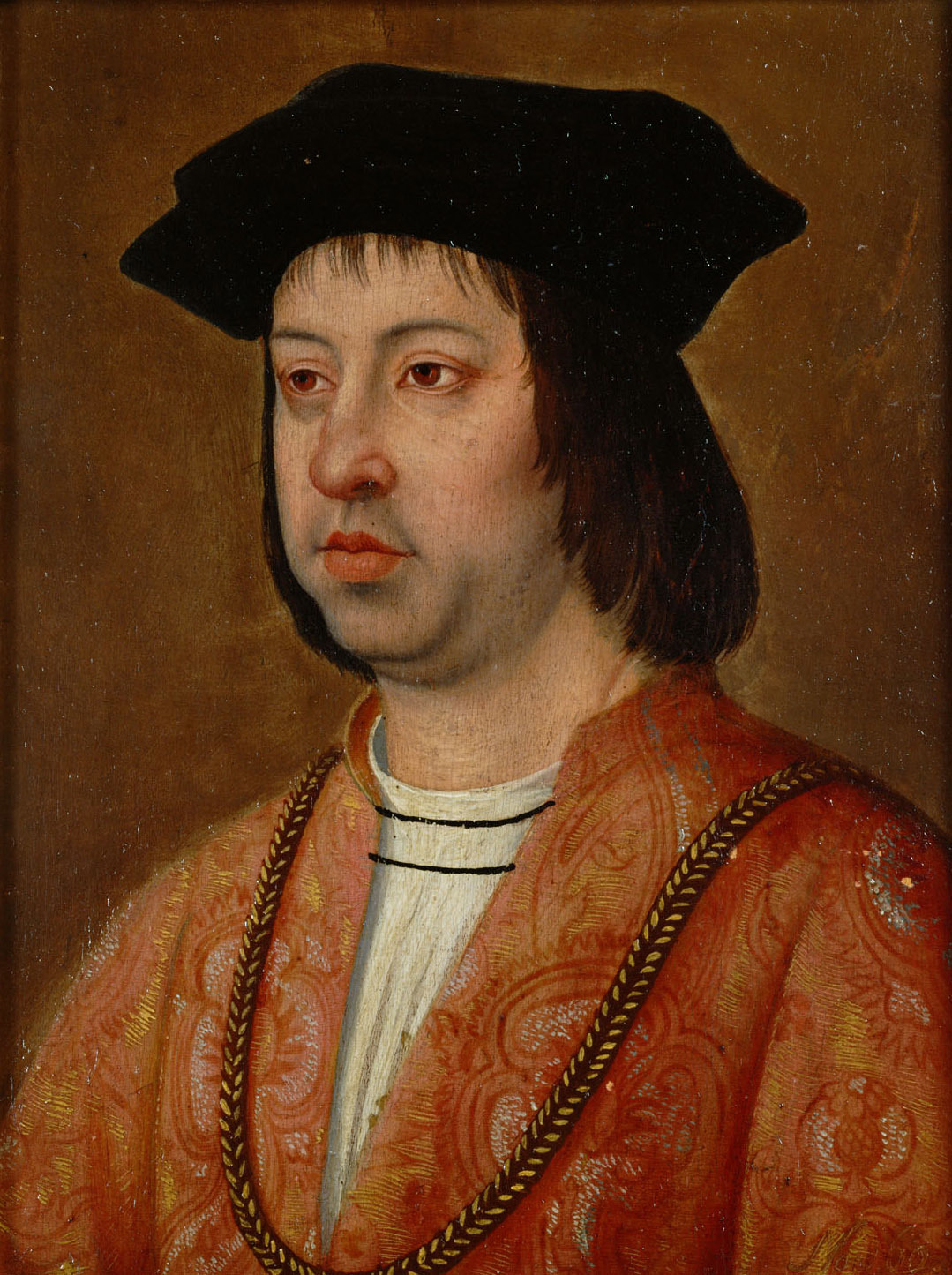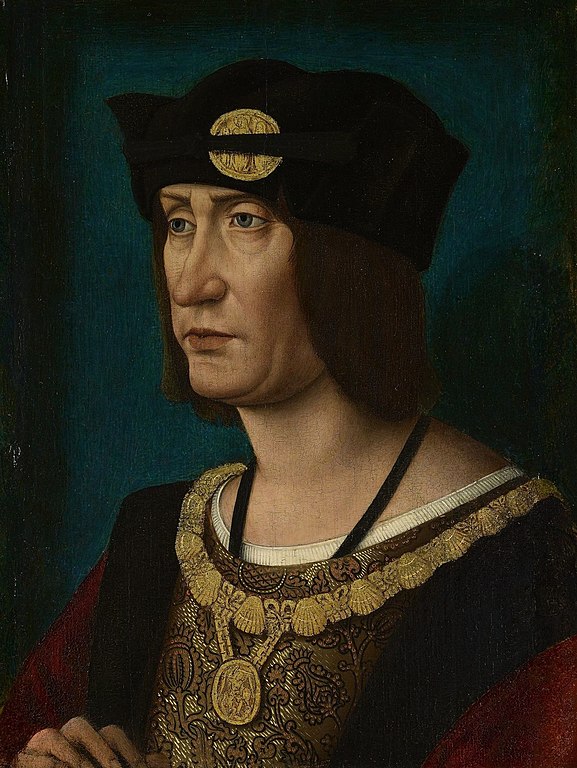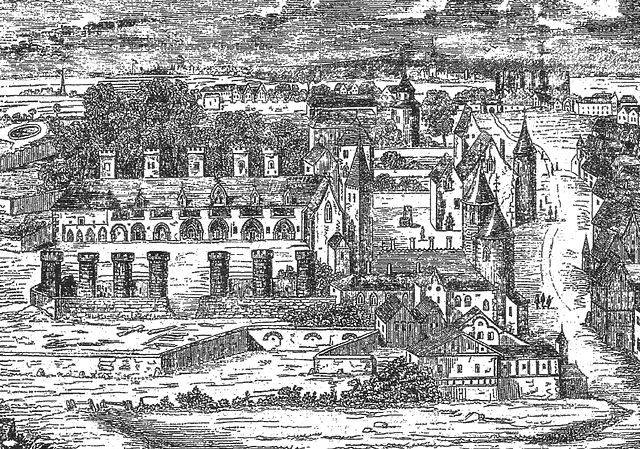 |
| Maximilian I |
Changing Circumstances
Thomas was
one of the knights who took part in a great tournament in February 1511, to
celebrate the birth of the Prince of Wales. A few weeks later he was honoured
to be bearing the coffin at the baby’s funeral. By now Thomas figured
prominently in Henry’s circle of intimates.
In May1512
Thomas undertook an embassy to Maximilian, the Holy Roman Emperor, alongside
were Sir Richard Wingfield and John Young. The following Spring
took Thomas and Sir Edward Poynings to Rome, where they concluded a
treaty on 5th April 1513 with Pope Julius II[i]. This was despite a diplomatic
incident when Thomas’s dog bit the Pope’s toe which Thomas then refused to
kiss, as was the custom at the time, as his spaniel had defiled it. Henry VIII
was now joined in an anti-French Holy League[ii] with Pope Julius, the Archduchess Margaret of Austria, Regent of the Netherlands and Maximilian.
 |
| Henry & Maximilian meet at the siege of Therouanne |
Thomas
returned home in June and when Henry VIII invaded France later in the summer,
Thomas led a company of a hundred men and took part in the siege of Thérouanne and the Battle of the Spurs.
Thomas’s
father-in-law meanwhile had recovered the family dukedom, being made Duke of
Norfolk in 1514 alongside the king’s great friend Charles Brandon who became the Duke of Suffolk;
‘The King being at Lambeth,
were create these estates following: that is to say, the Earl of Surrey, Sir
Thomas Howard senior, Earl Marshal and Treasurer of England, create Duke of
Norfolk; the Viscount Lisle, Sir Charles Brandon, late Marshal of the king’s
army, was create Duke of Suffolk; the Lord Howard, Sir Thomas Howard the
younger, Lord Admiral of England, was create Earl of Surrey.’[iii]
Foreign Policy
 |
| Ferdinand of Aragon |
In June 1514
Henry fell out with Katherine’s father and spat out complaints about her. There
had already been problems between the two kings, when Ferdinand had failed to
support an English expedition to take Bayonne[iv]; instead he’d sent his troops into Navarre, leaving the English to mutiny and return home. A mortified
Henry had to accept his father-in-law’s caustic comments on English
reliability.
In the following year Ferdinand made peace with
Louis XII, just as Henry was about to attack
France. But in 1514, under the guiding hand of Henry’s new adviser Thomas Wolsey, English policy changed. Henry made his peace with France,
turning the tables on Ferdinand and Maximilian, both of whom had used Henry’s
naivety about foreign affairs to extend their power bases at the expense of the
English.
Wolsey was
able to negotiate possession of Tournai, a large amount of gold and the marriage between Henry’s sister Mary and Louis[v]. Henry now felt able to
tell the Spanish ambassador some home truths, the poor man even complained that
he was;
‘A bull, at whom everyone
throws darts.’[vi]
And although
Katherine was again pregnant, there was talk of a divorce. As a result of
Wolsey’s diplomacy England was recognised once again as a power to be taken
into consideration. Henry wrote to Pope Leo X requesting a cardinal’s hat for Wolsey;
‘Such are his merits that I
esteem him above my dearest friends, and can do nothing of importance without
him.’[vii]
The request
was refused.
A Tudor Courtly Education
 |
| Margaret of Austria |
Anne at
least of the Boleyn girls had a relatively broad education for a girl. Both
girls were trained for a life at court and marriage. The composer Richard Davy was Thomas’s chaplain from 1506-15 and may have taught the
two girls music; Anne was an excellent musician, singer and dancer, a skilled
needlewoman as well as being competent at poetry. The poet Thomas Wyatt lived at nearby Allington.
All the
Boleyn children were taught to speak fluent French, a language with which Anne
apparently struggled, unlike her father, and it was living in the courts of
France and Brussels that gave her some proficiency. The children of the
nobility were also taught to ride, hunt and hawk; a skill that Thomas excelled
in.
On an
embassy to Archduchess
Margaret at her court in Mechelen Thomas ingratiated himself with
Margaret. He extolled the virtues of Anne and Margaret offered her a place at
her court as one of her eighteen maids of honour. Returning home in the spring
of 1513 Thomas immediately despatched Anne to Mechelen in the care of a knight
named Broughton.
Margaret was
delighted with her new maid, writing to Thomas;
‘A present more than welcome
in my sight. I hope to treat her in such a way that you shall be quite satisfied
with me.…….I am more beholden to you for sending her than you can be to me for
receiving her.’[viii]
The French Marriage
 |
| Louis XII |
In the
autumn of 1514 the 18 year old Princess Mary was chosen, as the victim of her
brother’s new foreign policy, to marry the 52 year old Louis of France, to be
his third wife[ix],.
For the sake of peace with France Henry had jettisoned the proposed marriage
between Princess Mary to Margaret’s nephew Charles[x].
Mary needed
ladies who could speak French and one of those chosen to go with her to France
was Mary. Anne was also to go at the special request of Princess Mary, as
Thomas wrote to Margaret;
‘To this request I could
not, nor did I know how to refuse.’[xi]
That Thomas
had two daughters as ladies of Mary’s court was an indication of just how high
he had climbed.
Anne wrote
to her father;
‘I understand by your letter
that you desire that I shall be a worthy woman when I come into the court, and
you inform me that the Queen will take the trouble to converse with me………..this
will make me have the greater desire to speak French.’[xii]
 |
| Hotel des Tournelles |
Louis and
Mary were married by proxy on 14th August at Greenwich Palace and then again on 9th October at Abbeville. Mary was one of the queen’s ‘Chamberers’,
serving in the queen’s private suite doing the menial tasks that were above the
dignity of the ladies-in-waiting. Lady Guildford[xiii] was the queen’s Lady of Honour and
had charge of the maids-of-honour.
Louis was
suffering from leprosy and his ravaged face must have been a shock to the young
queen. After the wedding the Duke of Norfolk visited Queen Mary to discuss
which of her English ladies would be sent home. But this meeting was pre-empted
by Louis who dismissed Lady Guildford and most of Mary’s servants, causing much
distress to his young wife. Mary was one of those retained, probably due to the
intervention of her grandfather.
Following
the wedding a series of jousts and tourneys were held at which the new Duke of Suffolk, Charles Brandon,
excelled. The tournaments were organised by Louis’ heir and cousin François. Christmas was celebrated at the Hôtel de Tournelles. François showed a clear interest in
his new queen, although this did not seem to bother Louis.
The Royal Widow
 |
| Louise de Savoie |
Anne
rejoined the queen and her ladies sometime after Christmas. By the time she
arrived Mary was a widow; Louis died on 1st January 1515 during a
fit of vomiting. Mary and her ladies were sent to the Hôtel de Cluny at the order of Louise de Savoie[xiv] for the prescribed 40 days of mourning, where Mary could
be scrutinised to ensure that she was not pregnant with Louis’ child.
Mary’s
letters home to her brother became more and more frantic as she received the
unwelcome attentions of the new French king. François indicated that he would
be happy to divorce his wife Claude, his intimations were not well received. François dismissed
Mary’s English ladies, replacing them with French maids of honour. He was
hoping to organise a second marriage for Mary that would be advantageous for
France, knowing that Henry was once again looking for an alliance with the
Hapsburgs.
Henry had
promised Mary that she could choose her second husband for herself, but had
every intention of breaking this promise. Henry decided to reinstate his plans
for Mary to marry Katherine’s nephew Charles, plans that horrified Mary who,
thinking him the ugliest man in Europe, declared;
‘I would rather be torn to
pieces.’[xv]
Mary took
advantage of Suffolk’s presence in France and, with the possible encouragement
of François[xvi],
the couple were secretly married on 5th March 1515. Henry was
enraged and it took much work on the part of Thomas Wolsey before the king’s
wrath was assuaged[xvii]. Mary and Brandon were
remarried on 13th May at Greenwich.
Bibliography
Cardinal
Wolsey – Mandell Creighton, McMillan & Co 1891
Henry VIII –
Robert Lacey, George Weidenfeld & Nicholson & Book Club Associates 1992
The Earlier
Tudors – JD Mackie, Oxford University Press 1992
Rivals in
Power – David Starkey (ed), Toucan Books 1990
The Six
Wives of Henry VIII – Alison Weir, Pimlico 1992
Mary Boleyn
– Alison Weir, AudioGO Ltd 2012
The Hapsburgs –
Andrew Wheatcroft
[ii]
The latest in a series of leagues set up by Julius; this aim of this one was to
throw the French (Julius’ pervious allies against the Venetians) out of Italy
[iii]
Rivals in Power - Starkey
[iv]
In south-west France
[v]
She was his third wife
[vi]
Henry VIII - Lacey
[vii]
Cardinal Wolsey - Creighton
[viii]
The Six Wives of Hnery VIII - Weir
[ix]
His second wife had died in the January and it was known that he was looking
out for a young wife
[x]
Later Charles V, Holy Roman Emperor, father of Philip II of Spain,
who was to marry Henry’s daughter Mary
[xi]
Mary Boleyn - Weir
[xii]
Ibid
[xiii]
Widow of Sir Richard
Guildford, one of Henry’s courtiers who had helped put down the Cornish
rebellion
[xiv]
François’ mother
[xv]
Henry VIII - Lacey
[xvi]
Hoping to forestall Henry’s planned alliance with the Holy Roman Emperor
[xvii]
Henry was eventually persuaded by Wolsey to fine the couple an enormous amount
of money, eliminating Brandon as one of the king’s advisers and leaving Wolsey
as Henry’s sole confidant
Note that April 1513 was by the old calendar as by the new calendar Pope Julius died by March 1513 to be succeeded by Leo X
ReplyDeleteI've always felt so sorry for Princess Mary, no wonder she ran off with Charles Brandon, oily opportunist that he was. At least Margaret got a young, energetic and erudite husband in James IV of Scotland.
Of personal interest is that the picture of Margaret of Austria shows a smocked neckline